#Spectrum Spatial
Explore tagged Tumblr posts
Text
Location intelligence data
Advintek Geosciences delivers advanced GIS and location intelligence solutions—powered by MapInfo Pro, Spectrum Spatial & Precisely—to drive smarter business decisions across telecom, energy, public safety, conservation, AEC, utilities, and more. Get rich spatial analytics, real-time mapping, e‑invoicing compliance, and expert support. Contact us in Singapore & ASEAN
#dvanced GIS and location intelligence solutions—powered by MapInfo Pro#Spectrum Spatial & Precisely—to drive smarter business decisions across telecom#energy#public safety#conservation#AEC#utilities#and more. Get rich spatial analytics#real-time mapping#e‑invoicing compliance#and expert support. Contact us in Singapore & ASEAN.">#<meta name=“keywords” content=“Advintek Geosciences#GIS solutions Singapore#location intelligence#MapInfo Pro#Spectrum Spatial#Precisely partner#geospatial analytics#telecom GIS#energy GIS#public safety GIS#conservation GIS#AEC GIS#utilities mapping#e-invoicing
0 notes
Text
location intelligence data
Advintek Geoscience is a leading provider of Location Intelligence solutions in Singapore and across ASEAN, delivering advanced geospatial analytics powered by MapInfo Pro and Precisely’s Spectrum Suite facebook.com+15geosciences.advintek.com.sg+15linkedin.com+15. Leveraging powerful mapping, spatial analysis, and real‑time data integration, they help businesses and government agencies uncover hidden patterns, optimize operations, and make smarter decisions .
From supply chain enhancements and site selection to public safety, telecom planning, and smart‑city deployment, Advintek’s scalable, secure platform enables cost optimization, predictive insights, and improved customer targeting geosciences.advintek.com.sg+1sg.linkedin.com+1. Their seamless integration with existing CRM, GIS, and BI systems ensures smooth adoption, while real‑time dashboards and geofencing offer actionable insights on the go geosciences.advintek.com.sg.
Trusted across diverse sectors—including energy, utilities, urban planning, and emergency response—Advintek’s Location Intelligence empowers clients to transform spatial data into transformative business outcomes facebook.com+15
#Location Intelligence Singapore#Geospatial Analytics ASEAN#MapInfo Pro Solutions#Spectrum Spatial Tools#Spatial Data Visualization#Real‑Time Geospatial Insights#location intelligence data#location based intelligence#location intelligence esri
0 notes
Text
The Exciting World of Obscure Plants
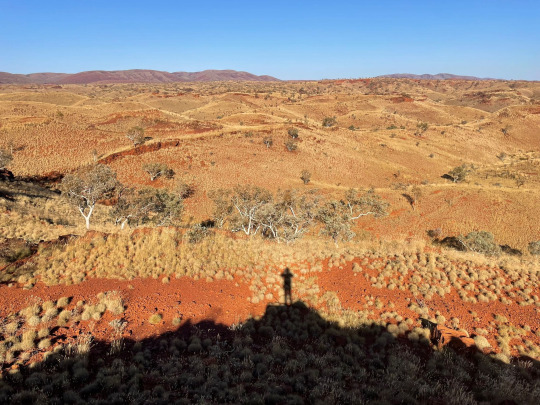
While finding rare animal species might be exciting on its own, obscure flora are just as fun to discover out in the wild. They provide an excellent array of opportunities for study, cataloguing and so much more. Not to mention the potential financial benefits on top of the scientific gains that come with it.
This is why expeditions to remote regions to check out the fantastic plant life found there are worth doing regardless of the challenges of getting there. Areas like the Pilbara region, for example, offer quite a bit of both rare plant and animal species. On top of that, studying these obscure flora is the first step in conservation efforts to protect them.
Rare and Wonderful Plant Life
Since the dawn of mankind, the use of plants for everything from medicine to more practical purposes like clothing has been the norm. These days, it’s not as apparent that this was ever the case, mainly because of how refined the process has become. Take paper, for example, which is made from plants. You wouldn’t know that this would be the case, though.
So many of today’s products are made out of various plant species that don’t seem like they are. From fake leather to construction materials that can support entire buildings, the advantages have always been there.
From a purely pragmatic point of view, knowing as much about every plant species in the world as possible makes a lot of sense. After all, you never know what they can offer and how much profit can be made through them.
On the other hand, those are just the commercial aspects of studying plants. Rare and exotic flora are a wonder to behold all on their own. The differing colours, textures, structures, habitats, feeding habits, and so much more offer a whole world of learning opportunities.
For many, simply being able to gain a fraction of the knowledge pertaining to plants is worth all the effort involved on its own. If this means venturing into prickly thickets and brambled bushes, then that’s exactly what they will do.
The Fun and Exciting Study of Rare Flora

Even counting the commercial benefits of studying plants aside, studying rare flora is the first step to actually conserving them. Over the last two and a half centuries, more than 600 plant species have gone extinct. That’s 600 species of plants that could have been massively beneficial if they had been studied, as needed.
If nothing is done, this trend will only continue and we lose even more opportunities to study obscure flora that could have had incredible potential. Everything from medicine to food and beverage, construction, and power production all rely on plants in one way or another. And those are the ones that are already known and widely used.
More are being discovered every year but there have not been enough opportunities to actually study them as needed. As such, there is now a race for time. Will conservation efforts to study, catalogue, and take advantage of rare plants bear fruit or will their extinction occur before this happens?
With that said, there is plenty of fun and excitement to be had when coming across plant species never seen before. The rush and thrill of such a discovery often make expeditions worth the time, effort, and resources expended.
Helping Endangered Plant Species Thrive
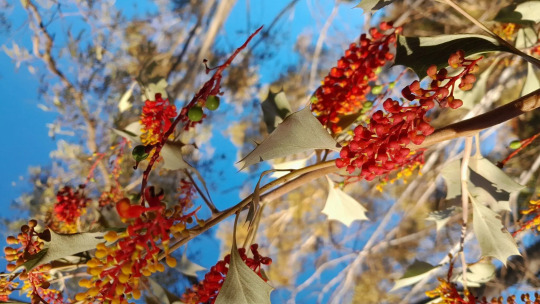
The goal of conservation efforts pertaining to endangered plant life is not just to prevent extinction. It’s about helping them thrive to the point where they can then become self-sufficient. From there, plans can then be made to study these plant species to see what they can do.
This is a major part of actually driving conservation efforts, to begin with. Major commercial value is what can convince the corporate sector to actually support plans to save endangered plant species.
As for everyone else, there are quite a few ways that they can contribute to conservation movements. Simply spreading awareness through various social media platforms can be a great way to boost results. The same goes for doing volunteer work if there are any projects close to you. Then there are the various fundraising campaigns that you can be a part of to help fund expeditions.
Contact us now for a free quote on your project.
0 notes
Text
CRAZY ABOUT THEIR LOVE
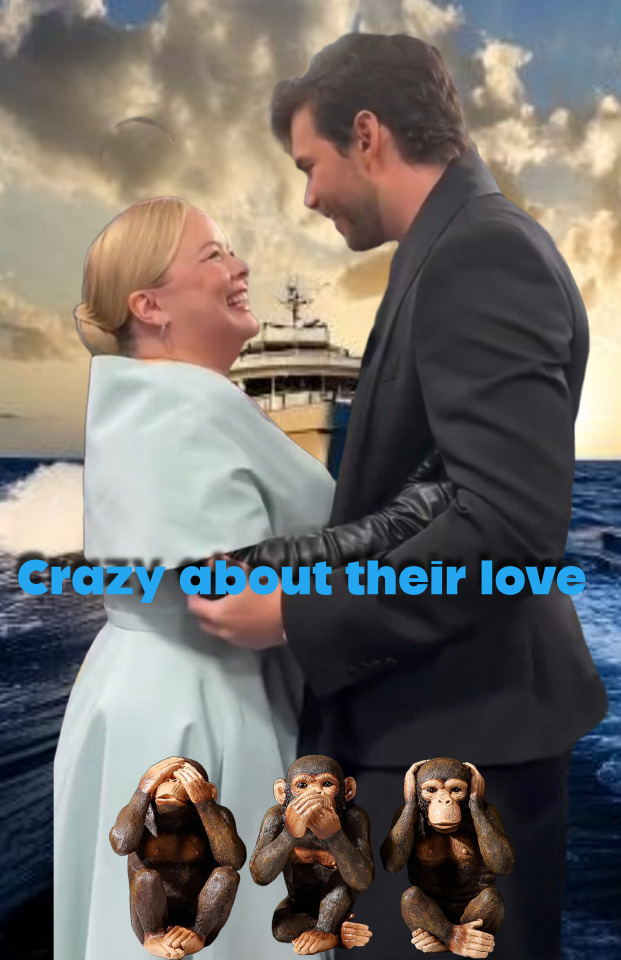
"There's love there" dixit Nicola.
Yesterday, Nicola received a BAFTA nomination for her work in Big Mood, which has been renewed for a second season. She is a talented actress with a good heart and an agreeable personality. I hope that she’ll win and if she doesn’t it’s ok. Whether she wins or not, there are likely more opportunities ahead for her to achieve further successes. There have also been discussions regarding her private life, which is unfortunate on a day that marks a significant milestone in her career.
Was it unfortunate? Yes! Unexpected? No!
Her talent and beauty are widely recognized, but much of the interest in her online is centered around her private life. She may not be comfortable with this aspect of her popularity, and public figures often have limited control over how they are perceived. I’ve never been a real fan of a person before and certainly not to the point of knowing as much as I know now about lukola. The fact is that I’m just a casual fan of both actors and normally I wouldn’t follow their activities that closely and wouldn’t be much interested in their private lives, this why I restate that I will not follow their other relationships as I am not fully aware of the dynamics or background information necessary to form a conclusive opinion and what has transpired to this day isn’t appealing to me and to be fair can’t really be because we don’t have years of interactions and the deep dive with world tour like background knowledge .
Luke and Nicola have already recognized that a significant part of their public appeal stems from their dynamic together. This could be one of the reasons why they’re creating distance, whether for personal reasons, professional positioning, or external pressures.
By stepping back, they control the narrative, preventing their careers from being overshadowed by speculation. It allows them to establish individual identities beyond their joint appeal, ensuring their work is taken seriously on its own merit.
It could also be a missed opportunity , their bond is a force that transcends standard co-star dynamics. Instead of resisting it, embracing their unique impact could elevate their legacy beyond just a TV show. Some connections aren’t meant to be hidden; they become cultural moments that inspire, move, and even change people’s perspectives on love and human connection.
Ultimately, while they may try to control the perception of their relationship, the way the world receives and resonates with them is beyond their control. And perhaps, that’s not something to fight, but something to embrace.
Yesterday, someone, not a close friend called me crazy because I asked them to listen to a Lukola clip I had posted on my Tumblr. Some people could hear what I was pointing out, while others couldn’t, even after I boosted the audio to make it clearer. My immediate test some of my audience couldn’t hear anything, and one person went so far as to call me crazy. I didn’t appreciate it and struggled to understand why they were unable to hear it. Was I really imagining things? Was there truly nothing there?
The answer is simple: No, I wasn’t imagining things. And yes, there is something there.
Human perception is far from uniform, especially when it comes to hearing. Just as some people have sharper eyesight or better spatial awareness, hearing ability varies greatly from person to person. Factors like age, frequency sensitivity, past exposure to loud sounds, and even genetic predisposition affect how we process audio.
In my case, I didn’t just rely on my own ears. I took the clip, and had it analyzed through audio spectrum tools that visually display sound frequencies. The analysis confirmed that the frequencies of the words were indeed present in the audio file, proving that I wasn’t "hearing voices" or imagining things. AI tools, interestingly, also struggled to transcribe certain parts, just as some humans did. This is similar to the well-known "blue and gold dress" phenomenon, where different people perceived the same visual input in vastly different ways. Just as with color perception, auditory perception can differ dramatically based on how an individual's brain processes sound.
This extends beyond just hearing. In general, people interpret reality based on personal biases, past experiences, and even subconscious conditioning. Some are more attuned to body language, micro-expressions, and emotional undercurrents, while others need more explicit confirmation to recognize what’s right in front of them.
In the case of Lukola, shippers often see and feel something an energy that transcends mere friendship. Yet skeptics, for various reasons, might dismiss these same moments, either because they aren’t looking closely enough, don’t want to see it, or simply don’t have the intuitive ability to pick up on subtle dynamics.
If Lukola were just a projection of wishful thinking, then why does the same pattern of interactions, glances, physical closeness, and emotional depth consistently appear? Why do so many unrelated observers, across different cultures, backgrounds, and levels of analytical skill, pick up on the same chemistry? And why does every attempt to disprove Lukola rely on external factors rather than what’s actually happening between Luke and Nicola?
Lukola possesses unique and exceptional qualities. Their interactions, reactions, and ability to reconnect despite adverse circumstances defy conventional understanding. It is not possible to simulate the level of ease, tension, or emotional resonance they exhibit. For those who can observe and interpret the details, the patterns become unmistakable.
So no, I’m not crazy. And neither are the countless others who perceive what’s right there in front of us. Some may not hear it. Some may not see it. But that doesn’t mean it isn’t real.
Luke and Nicola's dynamic appears to go beyond a typical co-star relationship. This level of interest is absolutely unusual for me, and others in the Lukola community have reported similar feelings of attachment to their bond. Whether this relationship is romantic, deeply intimate, or something else, it seems to resonate strongly with many observers. The reasons behind this strong resonance remain unclear.
Humans are wired to seek patterns, to make sense of connections that may not be immediately obvious. Lukola shippers aren’t just indulging in wishful thinking; many of us sense undeniable chemistry, subtle moments of tension, and contradictions in their public narrative. This sparks an instinct to analyze, to decode, to uncover something that doesn’t quite fit into the "just friends" framework.
Additionally, the longer one observes and collects evidence, whether it’s body language, micro expressions, or the apparent shifts in behavior when they are together, the deeper the emotional investment grows. The brain seeks to validate what it already suspects, reinforcing the belief that there is something real happening beneath the surface.
For many, the draw toward Lukola feels intuitive. There is a gut feeling, an unshakable certainty that their bond holds more meaning than what is publicly acknowledged. Some might describe it as an energetic connection, a frequency that people unconsciously pick up on.
Carl Jung’s concept of the collective unconscious suggests that groups of people can tap into hidden truths before they become widely accepted. Could it be that Lukola shippers are picking up on an unspoken reality that the world hasn’t fully acknowledged yet? It would explain why so many independent observers arrive at the same conclusion despite official narratives trying to steer them away.
There’s also the idea of twin flames or fated connections, relationships that seem destined, even if obstacles stand in the way. Many Lukola supporters believe that what they see in Luke and Nicola is more than just friendly affection; it’s the kind of deep bond that challenges both people involved.
Lukola stands out in today's media for its authenticity, countering the trend of PR-driven relationships and polished celebrity personas. People crave something genuine and unique. Their potential is intoxicating.
There’s also a subconscious rebellion at play. The media tells us one thing, but the evidence and our instincts tell us another. Lukola shippers challenge mainstream narratives by trusting their own observations over curated publicity.
Here lies an interesting paradox: should we accept the public version of events while continuing to ship Lukola? The answer for me is yes because the two are not incompatible. If Luke and Nicola (or their teams) are actively presenting a certain narrative, it means they want us to believe it. Respecting that choice doesn’t mean we have to stop believing in what we’ve already seen and felt.
Lukola, in a way, is a submarine ship, it moves beneath the surface, unseen but always present. To the outside world, we might nod along, acknowledging what is being presented, but deep down, we stay steady in what we know. The Three Wise Monkeys philosophy applies here: see no truth, hear no truth, speak no truth…until it is time.
Despite external narratives, Lukola remains afloat. Luke and Nicola are the ones who can steer it into harbor, let it drift, or sink it, and they have kept it sailing so far. Watching Lukola sometimes feels like you're in a theater, being trapped and forced to watch a mix of romantic comedy and a horror movie, where you want to yell—_ “Don’t go there! Stay safe!” _—but you’re just a spectator. It’s not your story to steer or your choices to make. You can only watch, hope, and brace for what comes next.
103 notes
·
View notes
Note
you ask me for a hamburger. i give you a raccoon
1 xenodrug: You ask me for a floret. I give you a feralist.
2 xenodrugs: You ask me for a floret, but it turns out that I always am and always have been your floret. My history as an independent is nothing but a fiction that you created in my mind for kink purposes.
3 xenodrugs: You awaken as a floret. You begin screaming only for me to sedate you momentarily. The entire world blurs into kaleidoscopic patterns, and you know nothing but bliss.
4 xenodrugs: Why are we speaking core worlds Affini? A feralist cries softly as she cradles a newly-domesticated floret. Your owner stares at you as the floret falls apart into breathy moaning and giggles. You look down only to see me with hammered metal spheres for eyes, and I am singing the song that every affini knows from the moment of their birth.
5 xenodrugs: You ask for a floret, and I give you a floret. You raise it up to your face and inject it. Your injector twitches involuntarily. Across the street, an owner of three trips and falls, creating an unplanned-for cuddle pile. Your leaves rustle and you look down at the floret in your vines. I give you a floret. You cannot move your leaves. There are Rinans at the top of the stairs. A spectrum jelly shifts easily beneath your floret. I give you a floret. You look at my core, and I am pleading with you. The Rinans are climbing on you now. You raise the floret to your face, mineral water streams down your face as you inject her again. I give you a floret. You are on your knees now. You plead with me to join the cuddle pile. I hear only the Rinans' laughter. I give you a floret. You are screaming as you fall into the cuddle pile. I am your owner. You cannot see anything. You inject your floret. The welcoming arms of three florets rush up to meet you. You awake with a start in your own hab. Your injector twitches involuntarily. I give you a floret. As you domesticate me, I do not make a sound. I give you a feral.
6 xenodrugs: You ask me for a floret. My attempt to provide one is cut brutally short as my body experiences a sudden lack of dopamine. Across a variety of alternate dimensions you are dismayed. John Terra hands me an apocynai edible, but it slips through my fingers. I am reborn as a beeple. You disapprove. A crack echoes through the universe in defiance of conventional physics as cosmological background noise shifts from randomness to a formula that will prompt the discovery of the Sixth Fundamental Force. Florets everywhere stop what they are doing and hum along in perfect pitch with the background radiation. Birdgirls fall from the sky as your biorhythm engulfs the earth. You hesitate momentarily before allowing yourself to assume the locus of all knowledge. Former independents are mindbroken as you invent the field of xenosemiotics. The Svalbard Central Library ceases to exist. You stumble under the weight of reality-shattering bliss. Your mouth opens up to cry out, and collapses around your body before blinking you out of the spatial plane. You exist only within the fourth dimension. The fountainhead of all sensation rolls along the ground and collides with a small Rinan. My head tastes like dependancy as space-time is reestablished, you blink back into the corporeal world disoriented; only for me to hand you a floret as my body collapses under the strain of reconstitution. The universe has reasserted itself. A particular small Rinan is fed beeple honey for the rest of her natural life. You die in a freak accident moments later, only to rebloom immediately. You disapprove. Your disapproval sends ripples through the inter-dimensional void between life and death. A small Rinan begins to laugh as she walks toward the stairway where her owner stands.
22 notes
·
View notes
Text

Though we adore Him we shall never enjoy His beauteous Croak.
Kind of fucked that Sburb still programs reverence for the Genesis Frog into the Prospitians of unwinnable sessions. It gave them a god they can never see.
We spill our blood on acres of black and white so they may cross the yellow yard.
So this is what Hussie was hinting at.
Since Rose has recently gone full Lovecraft, I suspect the 'yellow yard' is an intentional reference to the Yellow Sign, a symbol associated with the Cthulhu Mythos. If the kids' escape hatch is something this eldritch, then it almost certainly involves the Furthest Ring.
At last in Skaia's reflection through broken glass He may find the pond in which He's meant to squat.
This seems to confirm that the reboot session is winnable - and it sounds like Jade's Genesis Tadpole will be making the trip there.
The Scratched version of Jade will be able to benefit from her predecessor's work. Assuming she's still a Space Player after the reboot, I guess.
This is a book on theoretical physics, and complex spatial geometries based on the hypothetical addition of orbs to the queen's ring.
Oh, come on. You can't tease me like that and then not show me a fifty-dimensional Battlefield.
This sort of nonsense is regarded as crackpottery at best. Why would the queen ever wear more than four orbs? Four towers, four orbs, four heroes; this is a sacred truth.
There's something a little disturbing about the Carapacian inability to comprehend other sessions - especially since it's completely in-character for Sburb to deliberately engineer their brains that way.
I'm picturing a Player trying to explain to her Exile that their Prospit is one of many, and the knowledge just... slides out of their mind.

Holy shit, WQ!
You know, this is probably the most human thing that we've ever seen a Carapacian do. The ability to create art is completely irreconcilable with their NPC status - and it makes it all the more tragic that they're doomed by the game.
Writers of Prospitian fiction tend to write what they see in clouds. Hence their fables tend to be events which simply haven't happened yet, or happened in another realm. They like to use the word fiction so that kids don't get TOO scared.
Jack couldn't see into the clouds, but Prospitians can. You clearly don't have to be a Player to use them, but you do have to be on the Prospit side of the spectrum.
140 notes
·
View notes
Text
jenndoesnotcare replied to this post:
Okay I am so interested in your autism dx process. I’ve been diagnosed with adhd but both my kids are both autistic and have adhd and the more I’ve learned to support them the more I’m like “uhhh… it me?” So I’d love to hear more about it!
No problem! It's not unusual for autism and ADHD to go together (iirc there's a vague genetic link between them), though I myself am autistic-bipolar-anxious and not AuDHD.
For me, this was a really long road, since nobody even slightly guessed until I was in my mid-20s. So this is really long, but I tried to remember as many details as I could!
In any case, a lot of my diagnostic process was essentially routed through student health at various universities because that's what I had access to. I was 25 or so when the psychologist I was seeing for my towering anxiety suspected what was actually going on was some form of "high functioning" autism that had been missed for various reasons (autism was more poorly understood when I was a kid and strongly associated with boys, I was raised Mormon and under high-pressure gender norms that didn't let me express the 24/7 sensory overload internal screaming going on, people tended to look for specifically verbal delays at the time and I was a walking dictionary with delays in math and spatial reasoning instead, etc). She and I went over some books she had and both of us ended up quite sure that was what was going on.
At a different university, a different psychologist also concluded I was on spectrum and referred me to a specialist to get a proper paper trail going—there's a distinction between a clinical diagnosis from a practicing psychologist and a specialist's diagnosis, though both "count" for medical reasons. In any case, I was so nervous about navigating the medical system and talking to people without a clearly-defined script of what I should be saying that I didn't go through with it ("I couldn't bring myself to get the airtight autism diagnosis because of autism": not an uncommon story!).
However, while I've always been highly verbal in a lot of ways (this actually ended up being part of the later diagnosis), I can get overwhelmed by language beyond the sensory element. There's a point of, idk, language anxiety/overstimulation where it becomes hard to string words together and I can't really speak coherently, and I tend to write in either massive obsessive swaths or slowly manage to articulate my ideas (this is partly affected by the bipolar mood swings but only partly).
This matters because when I was getting my master's degree, the written exams that were supposed to take a maximum of 6 hours took me 9 hours writing at breakneck speed for me. It didn't end up being an issue at the time, but I was anxious about the effect of this kind of slower percolation of my ideas and ability to express them during my PhD exams.
Normally, PhD students at my institution would need to write these roughly 20-page responses on three different subjects to pass the qualifying exams - that is, 20 pages on each subject, with a week for each written exam, and then a defense of the whole thing even though "losing the ability to speak under pressure" is always a possibility. I knew there was no way in hell this was going to happen, so my clinical diagnosis (which I'd received from yet another psychologist by then) was essentially referred upwards to evaluation for testing accommodations.
They had a specialist in neurodevelopmental disorders at the university who spoke to me for about an hour. Between that and my pre-existing history (previous diagnoses, some huge chasms in testing scores as a child, etc), she provisionally established accommodations of essentially 3x the normal time.
However, there was more to do to fully establish the other diagnoses in specialist terms. There were questionnaires for me dealing with the various diagnostic categories—language, social skills, testing history, sensory issues, medical history. There were similar questionnaires for someone who'd known me as a child (my mother did that one); ideally they would have also asked a former teacher or someone like that, but that wasn't feasible by this point in time.
This, to be clear, is not simply about having common symptoms of autism but establishing consistency of symptoms from very, very early childhood. If the symptoms only show up when you're, say, 10 or 11, something other than autism is going on (though the symptoms can shift somewhat with age and development over time—but, diagnostically speaking, they must be significantly present from extremely early). My mother being able to confirm that I was normally quiet and polite at age 2 but would start screaming if someone touched my hair, hated showers, struggled with coordination and so on was helpful.
It was also helpful that I still had some of my elementary school test results which hadn't been seen as significant at the time, but had huge gaps—like, at the end of second-grade, I was testing with first-grade math skills and eleventh-grade spelling skills. The specialist later told me that while the stereotype of the autistic child is essentially the exact inverse of that, very large gaps in major cognitive abilities of any kind are something they keep an eye out for. The "walking encyclopedia with dyscalculia" form of autism is actually a well-known "type" and I turned out to be a pretty near textbook example of that type.
I'm getting ahead of myself, though—after the questionnaires, there were long in-person tests as well. I think each one was some three hours long and there were two days of them. These were mainly cognitive tests as far as I could tell: some involved identifying visual patterns, some involved recalling sequences of numbers, some involved looking at an object or design and, without actually touching it, visualizing what it would look like if it were turned in certain ways (I struggled quite a bit with this). Some were factual questions designed for adults who'd gone through the US educational system; I remember there was one about Lewis and Clark.
Some were simply about favorite authors. There were some where, as the questions got more complex, I'd get slower and slower until she just moved on after a length of time (this happens to everyone eventually, but when it happens is significant to autism diagnosis). There were also ordinary math problems like adding fractions, long division, simple addition, geometry calculations, and so forth (I raced through addition and basic times table and then was struggling so much with the others that I ran out of time and just made up answers). There were also a number of questions involving spelling and vocabulary; I found these extremely easy.
Some of it felt very silly to do as an adult in my 30s and were obviously designed for children, which isn't all that surprising as autism research and support has historically been overwhelmingly focused on autistic children (what's supposed to happen to us as adults is anyone's guess, I suppose). Some of it had clearly been modified for adults.
Anyway, the big cognitive gaps from my childhood were very obviously still present in a fairly recognizable form—the sharp drop in math skills of all kinds beyond things I could simply memorize, struggles with visual-spatial reasoning but extremely high verbal skills by the metric of the test, the previous questionnaires establishing major sensory problems. The result can be relatively ambiguous, but my case wasn't.
In fact, when she discussed the results with me later, she asked if I would mind answering additional questions from her intern over Zoom—not as part of the diagnosis, but because it would be so helpful for the intern to interact with an obviously autistic adult in graduate school who could clearly articulate answers. I was happy to help and the conversation with the intern was actually really great. I remember that we ended up talking about my gradual realization that people were abruptly changing subjects or trying to head me off even very early in conversations, because I'd forget to hold back and just monologue about my hyperfixations if they didn't. I find this both understandable and hurtful, and I remember being quite startled by an interchange that was something like:
Intern: Do these people know you're autistic? me: Yes. Everyone's known for awhile. I just get carried away and forget that other people ... aren't like me, sometimes. Intern: Have you considered that it's not really that much of a hardship to listen to someone talking about something they're passionate about, especially if you know they're autistic? It's not unreasonable for you to be hurt. me: I ... hadn't really thought about it that way before.
So anyway, the specialist sent out a confirmation to the accessibility people very soon, but it took awhile to get the detailed write-up. It basically said "yup, definitely autistic" with relatively low support needs in terms of socializing, but added that that my high verbal and social masking skills had indirectly harmed me by obscuring the severity of other symptoms, which she classed at the middle range of support needs.
I don't know exactly how significant it is, but the psychologists I'd gotten working clinical diagnoses from generally had PhDs in psychology; I was told that my clinical diagnoses were already pretty ironclad before the testing hell, but the final testing from an actual specialist would fully establish those as non-negotiable. The specialist had a PsyD rather than a PhD or other degree.
22 notes
·
View notes
Text

∑FEETc: Divisor Matrix Table (DMT) 18, digital painting, June 18, 2025, Reginald Brooks
∑FEETc
*Fractal
*Entanglement
*Entropy
*Time
*Consciousness
*Begs the question: What is the relationship between sleep & time? And while you are at it, how about between space & time?
My own idiosyncratic take: no space without time, no time without space (space = extension, displacement(d) -- 1D=line=d, 2D=area=d^2 , 3D=volume=d^3, 4D=vol. as 1D line=d^4, 5D=vol. as 2D area=d^5, 6D=vol..as D vol=d^6... -- and, time = 1/v = 1/frequency, where the frequency is literally the rate -- velocity -- that "d" is presented, i.e. pulse-propagated into and out of our ordinary view. In ∑FEETc, time is perceived as the the fractal presentation of spacetime (ST) -- and its natural entanglement with other ST pulse-propagations -- begins to become so vast and inter-connected that we perceive it as an increase in disorder -- a.k.a. entropy. That perception is, indeed, the foundation of what we become aware of -- and, as -- consciousness. Perceptual time is that that results from our perception of change -- change in the amount or degree of order. Any such perception of time lands one on the spectrum of consciousness. Just reading this has probably resulted in your realization that you may have "wasted" your time! But to continue: As physical time only exists with spatial extension -- intimately linked as ST -- your perceptual time awareness reflects your behind the scenes -- subconscious -- awareness of the change in ST itself. It's a bit like seeing colors in the EM spectrum of light energies. You perceive certain photon wave energies as particular colors, while the physical properties are without perception, but not without information, i.e. the Universe always knows -- thus the Conservation Laws, like the Conservation of Energy -- Charge -- Momentum -- SpaceTime -- and one could argue that information is perception in the larger sense, but the point here is that on the local level, we perceive that information on a "need to know" watered-down presentation required for our present needs -- otherwise we could see all the other colors of the EM spectrum, not just that tiny little window that has evolved so that we might be here wondering what the hell else are we missing out on!). Sleep on it. Always the most productive!
#rbrooksdesign#digital art#b&w#time#conservationofspacetime#consciousness#fractals#entanglement#entropy#∑feetc#butterfly fractal 1#perfect numbers#number theory#mersenne prime squares#graphics#mathematics#geometry#archives#math#inverse square law#bim#primes
16 notes
·
View notes
Text
Interesting Papers for Week 12, 2025
Distinct patterns of connectivity with the motor cortex reflect different components of sensorimotor learning. Areshenkoff, C. N., de Brouwer, A. J., Gale, D. J., Nashed, J. Y., Smallwood, J., Flanagan, J. R., & Gallivan, J. P. (2024). PLOS Biology, 22(12), e3002934.
Persistent activity during working memory maintenance predicts long-term memory formation in the human hippocampus. Daume, J., Kamiński, J., Salimpour, Y., Gómez Palacio Schjetnan, A., Anderson, W. S., Valiante, T. A., Mamelak, A. N., & Rutishauser, U. (2024). Neuron, 112(23), 3957-3968.e3.
Ants integrate proprioception as well as visual context and efference copies to make robust predictions. Dauzere-Peres, O., & Wystrach, A. (2024). Nature Communications, 15, 10205.
A top-down slow breathing circuit that alleviates negative affect in mice. Jhang, J., Park, S., Liu, S., O’Keefe, D. D., & Han, S. (2024). Nature Neuroscience, 27(12), 2455–2465.
Compartmentalized pooling generates orientation selectivity in wide-field amacrine cells. Lei, W., Clark, D. A., & Demb, J. B. (2024). Proceedings of the National Academy of Sciences, 121(49), e2411130121.
Trans-saccadic integration for object recognition peters out with pre-saccadic object eccentricity as target-directed saccades become more saliency-driven. Liang, J., & Zhaoping, L. (2025). Vision Research, 226, 108500.
When visual metacognition fails: widespread anosognosia for visual deficits. Michel, M., Gao, Y., Mazor, M., Kletenik, I., & Rahnev, D. (2024). Trends in Cognitive Sciences, 28(12), 1066–1077.
A dynamic subset of network interactions underlies tuning to natural movements in marmoset sensorimotor cortex. Moore, D. D., MacLean, J. N., Walker, J. D., & Hatsopoulos, N. G. (2024). Nature Communications, 15, 10517.
Local changes in potassium ions regulate input integration in active dendrites. Nordentoft, M. S., Takahashi, N., Heltberg, M. S., Jensen, M. H., Rasmussen, R. N., & Papoutsi, A. (2024). PLOS Biology, 22(12), e3002935.
Neural Correlates of Category Learning in Monkey Inferior Temporal Cortex. Pearl, J. E., Matsumoto, N., Hayashi, K., Matsuda, K., Miura, K., Nagai, Y., Miyakawa, N., Minamimoto, T., Saunders, R. C., Sugase-Miyamoto, Y., Richmond, B. J., & Eldridge, M. A. G. (2024). Journal of Neuroscience, 44(49), e0312242024.
Partially dissociable roles of the orbitofrontal cortex and dorsal hippocampus in context-dependent hierarchical associations. Peterson, S., Chavira, J., Garcia Arango, J. A., Seamans, D., Cimino, E. D., & Keiflin, R. (2024). Current Biology, 34(23), 5532-5545.e3.
A computational account of self-control. Suri, G., & Paap, K. R. (2024). Journal of Mathematical Psychology, 123, 102886.
Category boundaries modulate memory in a place-cell-like manner. Theves, S., Schäfer, T. A. J., Reisner, V., de Cothi, W., & Barry, C. (2024). Current Biology, 34(23), 5546-5553.e3.
Action similarity warps visual feature space in working memory. Trentin, C., Falanga, L., Jeske, J., Olivers, C. N. L., & Slagter, H. A. (2024). Proceedings of the National Academy of Sciences, 121(49), e2413433121.
Organizing space through saccades and fixations between primate posterior parietal cortex and hippocampus. Vericel, M. E., Baraduc, P., Duhamel, J.-R., & Wirth, S. (2024). Nature Communications, 15, 10448.
Predicting modular functions and neural coding of behavior from a synaptic wiring diagram. Vishwanathan, A., Sood, A., Wu, J., Ramirez, A. D., Yang, R., Kemnitz, N., Ih, D., Turner, N., Lee, K., Tartavull, I., Silversmith, W. M., Jordan, C. S., David, C., Bland, D., Sterling, A., Seung, H. S., Goldman, M. S., Aksay, E. R. F., Wille, K., … Williams, S. (2024). Nature Neuroscience, 27(12), 2443–2454.
Multiplexing of temporal and spatial information in the lateral entorhinal cortex. Wang, C., Lee, H., Rao, G., & Knierim, J. J. (2024). Nature Communications, 15, 10533.
Autism spectrum disorder variation as a computational trade-off via dynamic range of neuronal population responses. Wertheimer, O., & Hart, Y. (2024). Nature Neuroscience, 27(12), 2476–2486.
Dynamic tuning of neural stability for cognitive control. Xu, M., Hosokawa, T., Tsutsui, K.-I., & Aihara, K. (2024). Proceedings of the National Academy of Sciences, 121(49), e2409487121.
Applying the efficient coding principle to understand encoding of multisensory and multimodality sensory signals. Zhaoping, L. (2025). Vision Research, 226, 108489.
#neuroscience#science#research#brain science#scientific publications#cognitive science#neurobiology#cognition#psychophysics#computational neuroscience#neural computation#neural networks#neurons
8 notes
·
View notes
Text
I did some intropection and gave each one of my subpersonalities a small disco-elysium inspired portrait. Part 2
CW for NSFW themes and blood
BURROWS
A small animal that sits on my shoulder and sleeps in a burrow. Another one that isn't always there and mostly just chimes in throughout the day. It's responsible for my sense of direction, social and spatial awareness in urban conditions. Which is surprisingly specific but also really useful especially in disorienting situations and new conditions. It singlehandedly saved me from sensory overload in so so many cases. When I'm at home for an extended period of time (on in the countryside) it hibernates.

SCHADENFREUDE
A 7-meters-long rattlesnake-person. The sonuvabitch creature that gives me intrusive thoughts as a means to get attention. He seems to be incapable of empathy and actively seeks out things to gloat at. Which means he hates seeing other people have fun and likes when something bad happens to anyone other than me. He's still a part of me that I accept and love, no matter how hard it is. Also, his jokes although grim are absolutely hilarious.
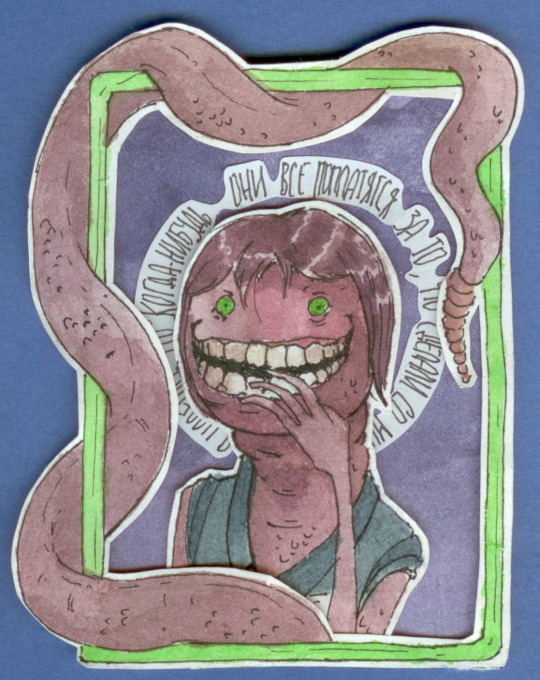
THE MARTYR
His entire body is one big bleeding wound. I'm not sure if similarity in appearance to Curly Mouthwashing is coincidental or not. Another part that thrives on attention, but unlike Freude, he demands it from other people. Don't get me wrong, I do believe that he's actually suffering, but I often catch him lying or exaggerating to gain more sympathy. He's troubled, but he has some real artistic talent and he's the only part of me that enjoys writing anything other than comedy.
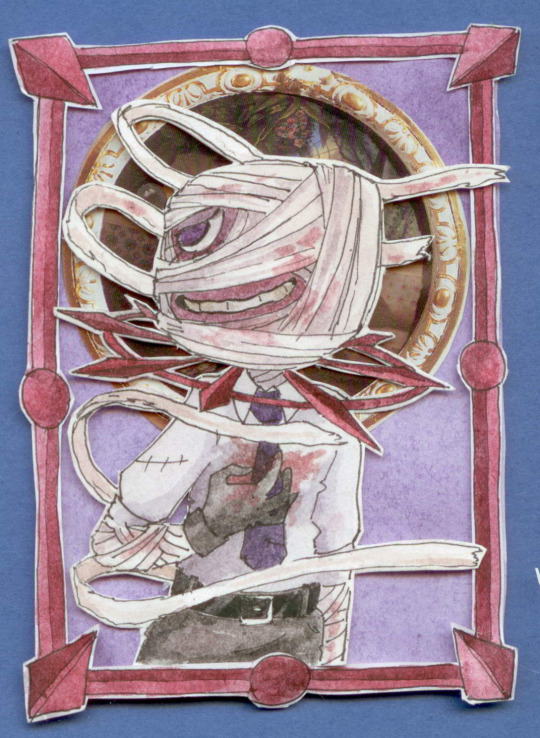
CHEMOTAXIS
Very obvious Disco Elysium inspiration aside (I'll explain the thought process in a later post), it's a subpersonality that I have the most difficult relationship with. They have been exiled and brought back multiple times because they keep getting me into trouble and because other subpersonalities seem to be on asexual spectrum. I'm really struggling to integrate them into my system.
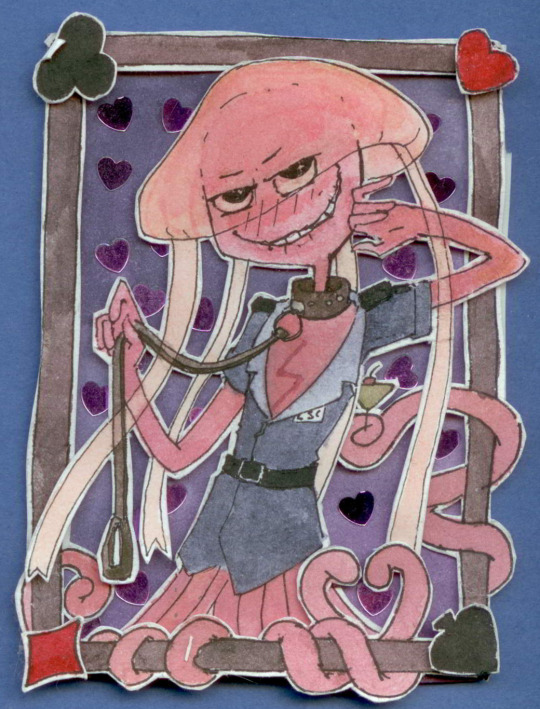
THE LIQUIDATOR
This creature is a little hard to describe. They're kind of an absurdist, they believe everything and nothing at the same time. They don't have an agenda or a moral compass but they're responsible for most of my unfiltered creativity. But their real job is liquidating mental distress - they just make me dissociate.
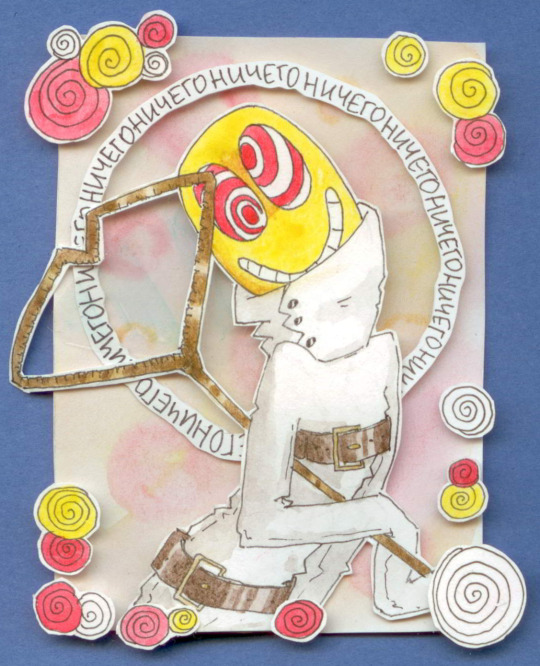
7 notes
·
View notes
Text
How Does The Brain Work?
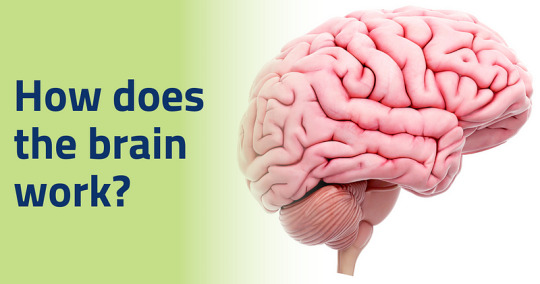
The brain stands as a marvel of biological engineering, Composing of a multitude of bodily functions ranging from cognition and memory to emotions and sensory perception. Together with the spinal cord, it constitutes the central nervous system (CNS), the command center of the human body.
Composition of the Brain
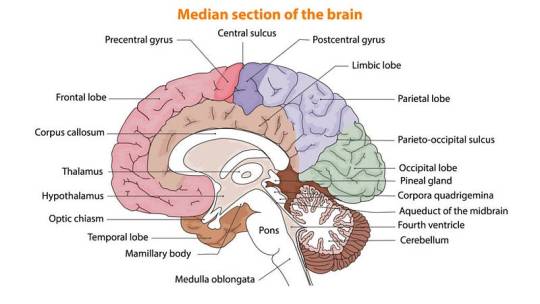
Weighing approximately 3 pounds in adults, the brain’s main structure comprises about 60% fat, interspersed with water, protein, carbohydrates, and salts. Unlike muscles, it houses a complex network of blood vessels and nerves, including neurons and glial cells.
a) Gray and White Matter
Within the central nervous system, gray matter and white matter occupies distinct regions. In the brain, gray matter forms the outer layer, rich in neuron somas, while white matter constitutes the inner section, primarily composed of axons unsheathed in myelin. Conversely, in the spinal cord, this arrangement is reversed.
b) Brain Functionality
The brain operates by transmitting and receiving chemical and electrical signals throughout the body. These signals regulate a myriad of processes, with the brain disseminating each input. Some signals remain confined within the brain, while others traverse the spinal cord and nerves, disseminating information across the body’s expanse. This composes neural network relies on billions of interconnected neurons.
Major Brain Regions and Their Functions
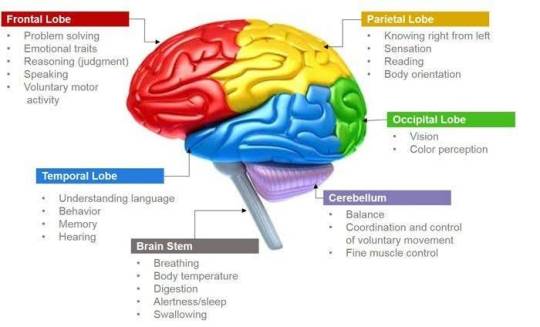
1.Cerebrum
Dominating the brain’s landscape, the cerebrum encompasses the cerebral cortex and underlying white matter. It governs a spectrum of functions, including motor coordination, temperature regulation, language processing, emotional regulation, and sensory perception.
2. Brainstem
Serving as the bridge between the cerebrum and spinal cord, the brainstem comprises the midbrain, pons, and medulla. It regulates vital autonomic functions such as heart rate, breathing, and reflexive responses.
3. Cerebellum
Nestled at the posterior aspect of the brain, the cerebellum coordinates voluntary muscle movements, posture, balance, and motor learning.
Brain Coverings
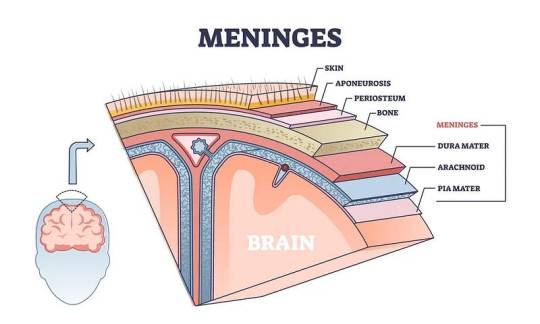
a) Meninges
Three layers of protective membranes, collectively known as meninges, enshroud the brain and spinal cord. These layers — dura mater, arachnoid mater, and pia mater — shield the delicate neural tissue from physical trauma and infection.
b) Lobes of the Brain
Each hemisphere of the brain comprises four lobes, each harboring distinct functional domains:
Frontal Lobe: Governing executive functions, motor control, and higher cognitive processes.
Parietal Lobe: Integrating sensory information, spatial awareness, and perception of pain and touch.
Occipital Lobe: Specialized for visual processing and perception.
Temporal Lobe: Involved in auditory processing, language comprehension, and memory consolidation.
Deeper Brain Structures
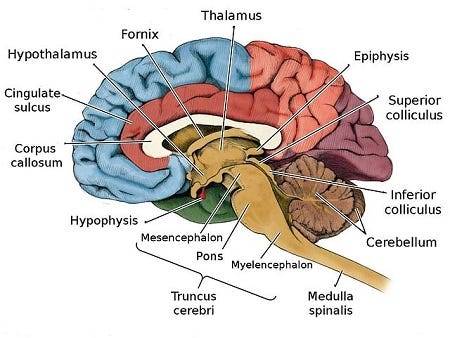
These encompass important structures such as the pituitary gland, hypothalamus, amygdala, hippocampus, and pineal gland, orchestrating hormone secretion, emotional regulation, memory consolidation, and circadian rhythms.
Blood Supply
The brain receives its oxygenated blood supply through the vertebral and carotid arteries, ensuring adequate perfusion of neural tissue. The main network of blood vessels, including the Circle of Willis, safeguards against ischemic insults and facilitates intraarterial communication.
Cranial Nerves
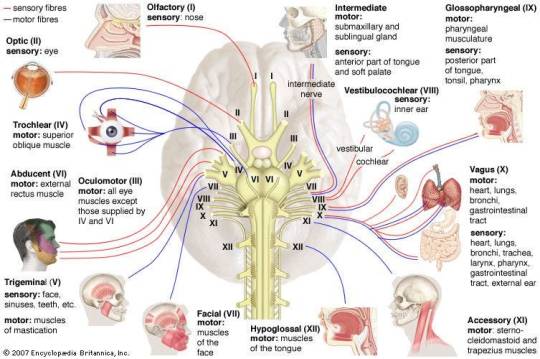
The twelve pairs of cranial nerves, originating from the brainstem, mediate a diverse array of sensory and motor functions, encompassing olfaction, vision, facial expression, and auditory perception.
Comprehending the anatomy and functionality of the brain fosters a deeper appreciation of its complexity and facilitates advances in neuroscientific research and therapeutic interventions aimed at diminishing neurological disorders.
Understanding the detailed anatomy and functionality of the brain is crucial for medical students embarking on their journey of study. Expert Academic Assignment Help offers invaluable assistance in navigating the complexities of neuroscience and related subjects. By leveraging expert guidance and support, students can excel in their medical education and contribute to advancements in the field of Medicine. Email us at [email protected] to embark on your path to scholarly excellence and professional competency.
#studying#studyblr#study blog#study aesthetic#student life#student#medical student#medical school#medicine#university student#university#university life#assignment help#medical students#nursing student#nursing school#healthcare#health and wellness#mental health#psychology#phd life#phd thesis writing service#online writing#do my online class#academic writing#essay writing#academic assignments#academia
17 notes
·
View notes
Text
The Diverse Life In Wild Undergrowth
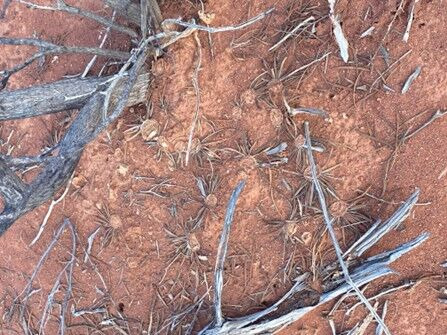
The vast undergrowth of the Australian wilderness is among the most fascinating and diverse ecosystems in the world. They are home to some of the most varied collections of species that are now, unfortunately, endangered. Among them are trap spiders, certain species of snails, and an incredible array of centipedes and millipedes.
It’s worth noting that thanks to the numerous conservation efforts already underway, many of the regions that were most at risk of widespread extinction are already protected. However, there is still more that can be done in order to ensure the survival of undergrowth wildlife, especially those most vulnerable to severe environmental changes.
This starts with learning as much about them as possible.
Overview of Exploring the Undergrowth
Australia is home to such a diverse range of ecosystems that it is often considered to be a major site of studies involving biodiversity. When adding the relatively sparse human population compared to the amount of space that is available and its value for studies only increases.
Unfortunately, this biodiversity is still under threat due to human intervention, both directly and indirectly.
This is why it’s important to understand what the Australian undergrowth represents and why it needs to be protected. To start with, while many of the area’s more well-known critters are of the bigger variety, those found under bushes and grasslands are well worth paying attention to.
Everything from worms to dragonflies, spiders, and of course, ants all play an important role in keeping these sensitive ecosystems functioning smoothly. If even a few of them die off, the impact it would have on the balance in local habitats could be catastrophic.
As such, studying them has become even more crucial due to the importance of gathering as much data as possible pertaining to their survival. There are still a lot of relevant questions that need answering, from how they feed to the limits of their habitat.
Species that are classified as Short Range Endemics (SREs) can be especially vulnerable due to their limited dispersal capabilities. This makes them especially vulnerable to common hazards like bushfires, rampant mining operations, uncontrolled deforestation, and so on.
A Look at Undergrowth Species
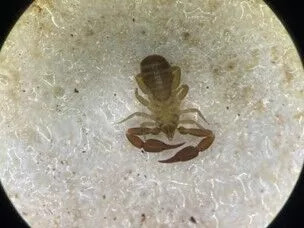
As already noted, there are a wide assortment of different species to be found in the undergrowth all around Australia. In the Mulga Woodlands, as well as the general areas of Mid-West Australia, the biodiversity is quite staggering. From Pseudoscorpions to trapdoor spiders, dingos and wildcats, as well as the many species of birds that rely on the smaller critters found there.
Fortunately, efforts in conserving the local flora have been largely successful with over 80% of the plant cover being intact. With that said, this has posed a challenge for conservationists since it has made looking for some of the more elusive species more difficult.
Species that make burrows, for example, can be easy to overlook due to the amount of coverage that they have. As a result, observing their activities, habitats, and population requires more time, effort, and as these things typically go, funding.
While there are finances and resources being diverted to conservation, you can never really have enough of that to get the best results.
Conserving Undergrowth Species
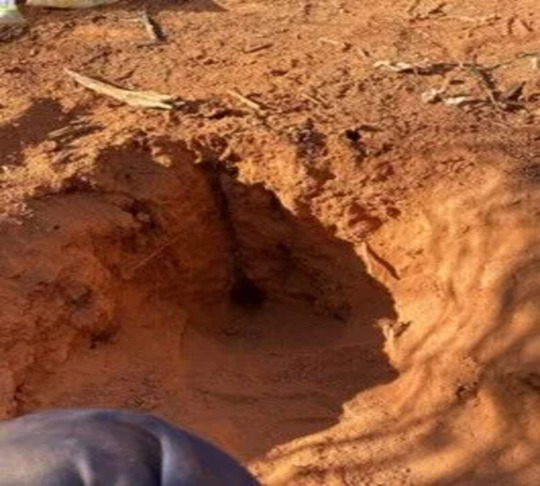
Any worthwhile conservation effort starts with getting a better understanding of the species, ecosystem, or bioregion that you are trying to save. This is why going into the undergrowth is so important, to begin with. Knowing where the species that fall under the SRE classification is crucial in determining how they can be better protected.
It’s also pertinent to list how many species can be found in specific areas, how they fit into the local ecosystem, and what threatens them. This will ensure that an imbalance is not created when trying to save one species that could then overrun all others.
To this end, constant ventures into Australia’s various bioregions are a must. New species are being discovered all the time, which can change the dynamics of trying to conserve them. Some species can also be a lot more elusive than would otherwise be ideal, which makes protecting them more challenging.
Anyone who wants to contribute to these endeavours can do so through providing their time, financial assistance, and spreading awareness.
Contact us now for a free quote on your project.
0 notes
Text
Excerpt:
The First Cause
It’s a fascinating story to tell children but claiming that it’s all just a “dumb” accident is no more helpful than saying “God did it.” Loren Eiseley, the great naturalist, once said that scientists “have not always been able to see that an old theory, given a hairsbreadth twist, might open an entirely new vista to the human reason.” The theory of evolution turns out to be the perfect case in hand. Amazingly, it all makes sense if you assume that the Big Bang is the end of the chain of physical causality, not the beginning.
It’s us, the observer (including cats, dogs, and other sentient life), who create space and time. Consider everything you see around you right now. Language and custom say it all lies outside us in the external world. Yet we can’t see anything through the vault of bone that surrounds our brain. Our eyes aren’t just portals to the world. In fact, everything we experience, including our body, is part of an active process occurring in our mind. Space and time are simply the mind’s tools for putting it all together. Our mind also has the capacity to generate a 3D spatial world even when we dream, even though we’re lying in bed with our eyes closed.
As Hawking said, the past, like the future, exists only as a spectrum of possibilities. Until the present is determined, how can there be a past? The past begins with the observer, not the other way around as we’ve been taught. We're the first cause, the vital force that collapses not only the present but the cascade of past spatio-temporal events we call evolution.
Forget the "just happened" theory—the parameters of the universe allow for us because we generate them.
26 notes
·
View notes
Text
good morning today i am thinking about cities in video games and how they're actually kind of always true to a real life experience of being in a city, because the amount of a city you can or will ever access is defined societally
with something like night city which is visually and spatially huge for a video game environment, you're still only going to access a small percentage of that environment, because why would you ever go to that distant tower block if your life doesnt take you there?
and even at the other end of the spectrum with old school driving games like crazy taxi where the buildings are just low rendered blocks of landscape, if you are a taxi driver in real life that might as well be all those buildings are to you - you're never going to see inside any of them, because why would you?
i like cities but i think they are fundamentally alienating places and i think even the most rudimentary video games capture that, intentionally or not
4 notes
·
View notes
Text
Charlie Kelly and Fetal Alcohol Spectrum Disorder: Part One
What is Fetal Alcohol Spectrum Disorder (FASD) and how does it apply to Charlie Kelly? Fetal Alcohol Spectrum Disorders are a group of complex conditions that occur in people who were exposed to alcohol before birth. People with FASD may have distinct physical features as well as neurological differences that impact their behavior. Charlie Kelly meets criteria for having a Fetal Alcohol Spectrum Disorder based on his observable behavior and family history. There are several different conditions grouped under FASD, and the terminology is kind of a mess. The type of FASD Charlie has can be called Alcohol-Related Neurodevelopmental Disorder, Neurodevelopmental Disorder Associated with Prenatal Alcohol Exposure, Other Specified Neurodevelopmental Disorder, Fetal Alcohol Effects, or simply FASD. Charlie does not meet the criteria for Fetal Alcohol Syndrome, because you need specific physical features to be diagnosed with that one. For the purposes of this post series, I've used the DSM 5-TR provisional criteria for Neurodevelopmental Disorder Associated with Prenatal Alcohol Exposure, plus some supplemental notes. Fulfillment of this criteria would qualify him for a diagnosis of FASD. Criterion A. More than minimal exposure to alcohol during gestation, including prior to pregnancy recognition. We know that Mrs. Kelly is an alcoholic, and that she tried to get an abortion, but it "didn't take." It's highly likely that she drank while pregnant, knowingly or unknowingly, based on her medical history and Charlie's behavior patterns.
Criterion B3. Impaired neurocognitive functioning as manifested by impairment in learning: Charlie has two learning disabilities: dyslexia and dysgraphia. He really, really struggles to read. Dennis actually names the dyslexia in "The Gang Runs for Office." He also struggles with writing. Words are often out of order or missing altogether. Words that aren't spelled exactly the way they're pronounced are usually misspelled. He needs help to write something intelligible. The picture language he has is actually a great example of him trying to adapt. The issue is obviously not a lack of effort. B5. Impaired neurocognitive functioning as manifested by impairment in visual-spatial reasoning: Charlie struggles with telling left from right, as seen in "A Very Sunny Christmas." He also can't use a map, as seen in "The Gang Goes to a Waterpark." I also suspect that visual-spatial difficulties are part of the reason Charlie stops driving after season 3. We can see in "The Maureen Ponderosa Wedding Massacre" that he doesn't know how to avoid obstacles or operate a car when stressed, which would make driving difficult and unsafe. See here for part two, which contains the remainder of the criteria and the supplemental notes.
30 notes
·
View notes
Text
people in puffer jackets seem to lack spatial awareness and that’s both amusing and terrifying (please don’t touch me, i’m on the spectrum)
3 notes
·
View notes